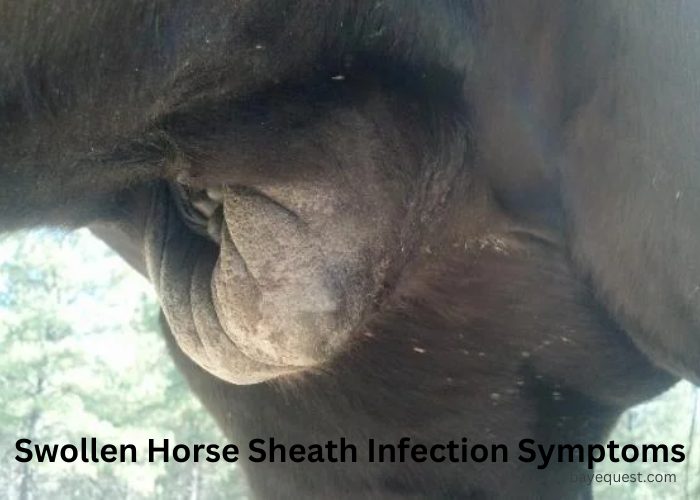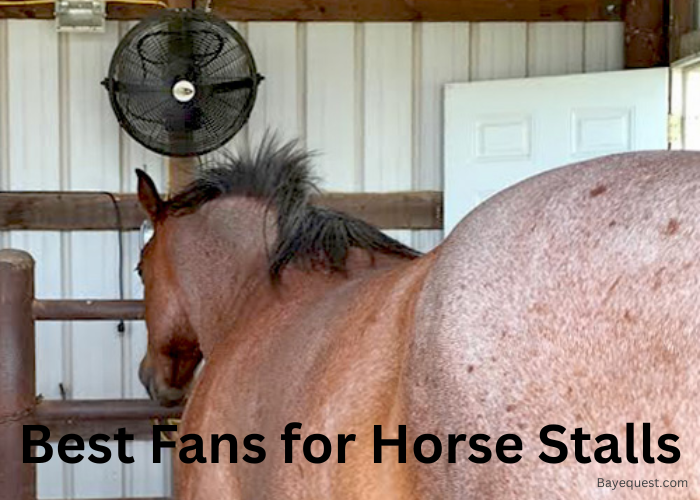A swollen horse sheath is something you shouldn’t ignore. It can mean infection, irritation, or other health issues.
Catching the signs early can help you take action before things get worse.
Your horse may show swelling, discomfort, or changes in behavior. Knowing what to watch for can make a big difference in keeping your horse healthy.
In this guide, we’ll go over the common symptoms and what they might mean. Understanding the problem is the first step to helping your horse feel better.
Swollen Horse Sheath Infection Symptoms: Key Takeaway
- Swelling
- Discharge
- Foul odor
- Pain and discomfort
- Inflammation of the penis
- Lethargy
- Loss of appetite
- Difficulty urinating
- Kicking at the abdomen
What is a Horse Sheath?
A horse’s sheath is the skin-covered pouch that protects the penis. It surrounds the penis when it is not extended.
The sheath has an outer layer of skin and an inner layer that lines the penis. In geldings and stallions, the sheath produces a natural lubricant called smegma.
This helps keep the area clean but can build up over time. So, you regularly need to clean the sheath to prevent infections and discomfort.
What is a Horse Sheat Infection
A horse sheath infection occurs when bacteria or fungi grow inside the sheath, leading to irritation, swelling, and discomfort. It often results from a buildup of smegma, dirt, or debris that isn’t cleaned regularly.
The infection can cause swelling, discharge, and a foul odor. In severe cases, it can affect the horse’s ability to urinate properly or extend the penis.
Prompt cleaning and, in some cases, veterinary treatment are needed to manage the infection and prevent complications.
Horse Sheath Anatomy and Physiology
The horse sheath is a protective fold of skin that covers and shields the penis when it’s not extended. It consists of two main layers: an outer layer of normal skin and an inner mucous membrane.
The inner membrane lines the penis and produces smegma, a natural lubricant. The sheath helps prevent dirt, bacteria, and debris from entering and causing infections.
In geldings and stallions, the sheath plays a role in both reproductive and urinary functions. During urination or breeding, the penis extends out of the sheath.
The sheath’s muscles control this movement, allowing the penis to retract afterward.
Proper sheath health is essential to avoid infection or inflammation, which can lead to swelling and discomfort.
Symptoms of Sheath Infections in Horses
Here are the key symptoms of a swollen horse sheath infection that every horse owner should watch out for:
1. Swelling
Swelling is the most noticeable sign of a sheath infection. The sheath becomes larger than normal, often feeling warm to the touch.
This happens because fluid builds up in the tissue as a response to infection or inflammation. The swelling can make it difficult for the horse to extend or retract the penis.
In severe cases, the swelling might extend to the surrounding areas, like the abdomen. Left untreated, swelling can worsen, leading to more serious issues.
2. Discharge
Discharge from the sheath is another common symptom of infection. It may appear thick and vary in color from yellow to green or gray.
The discharge is often smegma mixed with pus, a result of the body fighting off the infection. You might notice this buildup around the opening of the sheath or on the horse’s legs.
This discharge can be sticky and unpleasant, sometimes accompanied by a bad smell. Any change in the color or amount of discharge should be checked by a vet.
3. Foul odor
A foul odor coming from the sheath is a clear sign of infection. The smell is usually caused by bacteria or fungal growth within the sheath.
As smegma and other debris break down, they produce this bad smell, indicating that something’s wrong.
The odor may be noticeable even without closely inspecting the sheath.
A healthy sheath doesn’t have a strong odor, so any unpleasant smell should prompt immediate attention. This is often one of the earliest signs that something is amiss.
4. Pain and discomfort
A horse experiencing pain and discomfort from a sheath infection may show several behavioral signs.
They might become agitated when you approach or touch the sheath area.
The horse may shift its weight, avoid standing still, or rub its sheath on objects to relieve discomfort.
Pain can make urination or movement difficult, and the horse might be reluctant to extend its penis.
In severe cases, the horse may flinch or kick when the area is examined.
5. Inflammation of the penis
Inflammation of the penis often occurs alongside sheath infections. The penis may appear red, swollen, or irritated when extended.
Inflammation is usually a response to the body fighting off bacteria or other irritants.
This condition can make the penis sensitive to touch and can lead to pain during urination or movement.
The horse may avoid extending the penis due to the discomfort caused by the inflammation.
If left untreated, the inflammation can cause further complications, including tissue damage.
6. Lethargy
Lethargy can be a sign that the infection is affecting the horse’s overall health. The horse may appear tired, uninterested in usual activities, and less energetic than normal.
Infections can take a toll on the horse’s immune system, leaving them feeling weak. This lack of energy may also be due to discomfort from the swollen sheath.
If the infection spreads, it can make the horse feel worse, causing them to rest more than usual.
7. Loss of appetite
A loss of appetite is often a symptom of more serious infections, including sheath infections.
When the horse is in pain or discomfort, it may eat less or refuse food altogether. This is a sign that the infection is affecting their overall well-being.
Loss of appetite can lead to weight loss and further weaken the horse’s immune system, making it harder to fight off the infection.
Noticing changes in eating habits, such as leaving food behind or showing disinterest in treats, is a key sign that the horse may be struggling with an infection.
8. Difficulty urinating
Difficulty urinating is a sign that the infection is interfering with the normal function of the sheath.
The swelling or pain may make it hard for the horse to extend the penis, leading to strain during urination.
You might notice the horse taking longer to urinate or making frequent attempts with little success.
In some cases, the horse may posture to urinate but produce only small amounts of urine.
Difficulty urinating can cause discomfort and, if not addressed, may lead to more severe urinary problems.
9. Kicking at the abdomen
Kicking at the abdomen is a behavioral sign that the horse is trying to relieve discomfort from the sheath infection.
The horse may repeatedly kick at its belly or sheath area, showing frustration or pain. This behavior is often seen in cases where the infection is causing significant discomfort or swelling.
Kicking can also be a sign of irritation or itching around the infected area.
Monitor this behavior, as frequent kicking could lead to injury or signal that the infection is worsening.
If the horse starts kicking more than usual, check the sheath for signs of infection.
Related read: How Strong is a Horse Kick?
Common Causes of Swollen Sheath Infection
Here are some common causes of swollen sheath infections in horses that can lead to discomfort and health issues:
1. Lack of regular cleaning
When the sheath isn’t cleaned regularly, dirt, smegma, and bacteria can build up. This increases the risk of infection and swelling.
Regular cleaning helps prevent harmful bacteria from growing and causing irritation.
2. Trauma or injury
Injuries to the sheath, such as cuts or bruises, can lead to swelling. Trauma may introduce bacteria into the area, causing infection.
Even minor injuries can escalate if not treated promptly.
3. Smegma buildup
Smegma is a natural secretion, but when it accumulates, it can create a breeding ground for bacteria. This buildup can block the sheath, causing inflammation and swelling.
Regular cleaning helps reduce smegma buildup and prevent infection.
4. Underlying health issues
Systemic health problems like immune disorders or infections can affect the sheath. These issues can make the horse more prone to infections, causing swelling.
Addressing the overall health of the horse is key to preventing sheath problems.
5. Phimosis
Phimosis occurs when the horse’s foreskin can’t retract properly. This condition can trap bacteria and smegma inside the sheath, leading to infection and swelling.
It often requires veterinary intervention to resolve.
6. Paraphimosis
In paraphimosis, the penis becomes stuck outside the sheath. This causes swelling as blood flow to the area is restricted.
If left untreated, paraphimosis can lead to serious complications, including infection.
7. Priapism
Priapism is a prolonged, often painful erection that doesn’t resolve. This condition can lead to swelling and infection due to restricted blood flow and exposure to bacteria.
It is a medical emergency that requires immediate veterinary attention.
Prevention and Care of Horse Sheath Infections
Preventing sheath infections starts with regular cleaning. Cleaning removes dirt, smegma, and bacteria that can lead to infection.
You should clean the sheath every few months. Use a gentle cleanser, and make sure to rinse well to avoid irritation. Routine cleaning helps keep the sheath healthy.
Regular inspections are also important. Check the sheath for signs of swelling, discharge, or bad odors.
Spotting these early can help you treat infections before they get worse.
Keeping your horse healthy overall is another way to prevent sheath infections. A balanced diet, plenty of water, and regular exercise support a strong immune system.
Healthy horses are less likely to develop infections. Regular vet check-ups can also help catch health issues that may affect the sheath.
If your horse injures its sheath, treat it right away. Even small injuries can lead to infections if they aren’t cleaned and monitored.
If the sheath becomes swollen or red, contact your vet for advice. Conditions like phimosis, paraphimosis, or priapism require immediate veterinary care to prevent serious complications.
Good grooming and hygiene are essential for infection prevention. Keep your horse clean, especially after outdoor activities.
Regular grooming helps reduce the buildup of dirt and bacteria, which can spread to the sheath. Proper care keeps your horse comfortable and healthy.
Treatment Options for Sheath Infections
A sheath infection requires quick and effective treatment. Here are some common treatment options to help your horse heal and stay comfortable.
1. Proper cleaning
The first step in treating a sheath infection is a thorough cleaning. This removes smegma, dirt, and bacteria that may be causing the infection.
Use warm water and a mild, vet-approved cleanser. Gently clean the sheath without causing irritation.
In severe cases, your vet may need to sedate the horse to perform a deep cleaning.
2. Antibiotics or antifungal medication
If the infection is bacterial or fungal, your vet may prescribe antibiotics or antifungal medications. These can be applied directly to the infected area or given orally.
Follow the dosage and treatment plan as prescribed by the vet to fully eliminate the infection.
3. Anti-inflammatory medications
For cases where there’s significant swelling or pain, anti-inflammatory medications may be needed. These reduce inflammation and relieve discomfort.
The horse may feel better and recover more comfortably.
4. Manual drainage or minor surgery
In severe infections that lead to large swellings or blockages, your vet may need to manually drain the area.
In rare cases, a minor surgical procedure may be required to relieve pressure and allow the horse to urinate normally.
Early treatment can often prevent the need for surgery.
5. Monitoring and follow-up
During treatment, keep a close eye on your horse’s progress. Watch for any improvements or signs of worsening.
If symptoms persist or get worse, contact your vet for further evaluation. Follow up with your vet to ensure the infection clears completely.
6. Ongoing maintenance
After the infection is treated, regular cleaning and inspections are crucial to prevent a recurrence.
Maintain good hygiene and monitor the sheath’s health to keep future infections at bay. Regular care is essential to maintaining your horse’s long-term well-being.
Infected Horse Sheath Symptoms: FAQs
Can laminitis cause a swollen sheath?
Laminitis affects a horse’s hooves, but it can lead to overall discomfort and inflammation in the body. While it doesn’t directly cause a swollen sheath, the stress and systemic inflammation from laminitis could contribute to sheath swelling in some cases.
Does bute help with swelling?
Yes, bute is an anti-inflammatory medication used to reduce pain and swelling in horses. It can help manage inflammation associated with sheath infections.
Related read: How Long Does Bute Stay in a Horse’s Body?
How often should I clean my horse’s sheath?
You need to clean your horse’s sheat after every 6 months. However, some horses may need more frequent cleaning depending on their activity level, environment, or individual needs.
How often do mares go into heat?
Mares go into heat, or estrus, every 21 days during the breeding season. This cycle occurs from early spring to late summer when daylight hours are longer, as mares are seasonal breeders. Each heat period lasts about 4 to 7 days, during which the mare may exhibit noticeable behavioral changes.
Conclusion
Keeping an eye on your horse’s sheath is key to their health. Catching symptoms like swelling, discharge, or discomfort early can prevent bigger problems down the road.
Regular cleaning, good hygiene, and routine checks are simple steps that go a long way.
If you spot any of the signs we’ve covered, don’t wait—get your vet involved to help your horse recover quickly.
Staying proactive means fewer health issues and a happier, more comfortable horse. Keep these tips in mind, and your horse will thank you for it.








